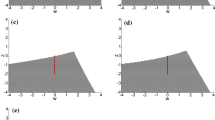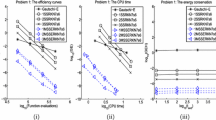Abstract
Splitting strategy is considered for the numerical solution of oscillatory chemical reaction systems. When applied to the harmonic oscillator, traditional splitting methods with constant coefficients are shown to be have some order of phase lag though they are zero-dissipative. Phase-fitted symmetric splitting methods of order two and order four are constructed. The result of the numerical experiment on the Lotka–Volterra system shows that the new phase-fitted symmetric splitting methods are more effective than their prototype splitting methods and can preserve the invariant of the system in long-term compared with the classical Runge–Kutta method.


Similar content being viewed by others
References
B.P. Belousov, A periodic reaction and its mechanism, in Oscillations and Travelling Waves in Chemical Systems, 1951, ed. by R.J. Field, M. Burger (Wiley, New York, 1985), pp. 605–613. (from his archives (in Russian))
B.P. Belousov, An oscillating reaction and its mechanism, in Sborn. Referat. Radiat. Med. (Collection of Abstracts on Radiation Medicine) (Medgiz, Moscow, 1959), p. 145
S. Blanes, F. Casas, A. Murua, Splitting and composition methods in the numerical integration of differential equations. Bol. Soc. Esp. Mat. Apl. 45, 89–145 (2008)
W.C. Bray, A periodic reaction in homogeneous solution and its relationship to catalysis. J. Am. Chem. Soc. 43, 1262–1267 (1921)
W.C. Bray, H.A. Liebhafsky, Reactions involving hydrogen peroxide, iodine and iodateion I: introduction. J. Am. Chem. Soc. 53, 38–44 (1931)
J. Butcher, Numerical Methods for Ordinary Differential Equations, 2nd edn. (Wiley, New York, 2008)
Z. Chen, J. Li, R. Zhang, X. You, Exponentially fitted two-derivative Runge–Kutta methods for simulation of oscillatory genetic regulatory systems. Comput. Math. Methods Med. 2015, Article ID 689137 (2015)
I.R. Epstein, J.A. Pojman, An Introduction to Nonlinear Chemical Dynamics: Oscillations, Waves, Patterns, and Chaos (Oxford University Press, New York, 1998)
C.P. Fall, E.S. Marland, J.M. Wagner, J.J. Tyson (eds.), Computational Cell Biology (Springer, New York, 2002)
L.K. Forbes, C.A. Holmes, Limit-cycle behaviour in a model chemical reaction: the cubic autocatalator. J. Eng. Math. 24, 179–189 (1990)
C. Gérard, A. Goldbeter, A skeleton model for the network of cyclin-dependent kinases driving the mammalian cell cycle. Interface Focus 1, 24–35 (2011)
A. Goldbeter, Biochemical Oscillations and Cellular Rhythms: The Molecular Bases of Periodic and Chaotic Behaviour (Cambridge University Press, Cambridge, 1996)
A. Goldbeter, Oscillatory enzyme reactions and Michaelis–Menten kinetics. FEBS Lett. 587, 2778–2784 (2013)
B.C. Goodwin, Oscillatory behavior in enzymatic control processes. Adv. Enzyme Regul. 3, 425–439 (1965)
E. Hairer, C. Lubich, G. Wanner, Geometric Numerical Integration: Structure-Preserving Algorithms for Ordinary Differential Equations, 2nd edn. (Springer, New York, 2006)
E. Hairer, S.P. Nørsett, G. Wanner, Solving Ordinary Differential Equations I: Nonstiff Problems (Springer, Berlin, 1993)
R.H. Hering, Oscillations in Lotka–Volterra systems of chemical reactions. J. Math. Chem. 5, 197–202 (1990)
H. Holden, K.H. Karlsen, K.A. Lie, N.H. Risebro, Splitting Methods for Partial Differential Equations with Rough Solutions (European Mathematical Society, Zurich, 2010)
W. Hundsdorfer, J.G. Verwer, Numerical Solution of Time-Dependent Advection-Diffusion-Reaction Equations (Springer, New York, 2003)
L. Gr Ixaru, G. Vanden Berghe, Exponential Fitting (Kluwer, Dordrecht, 2004)
L. Gr Ixaru, G. Vanden Berghe, H. De Meyer, Frequency evaluation in exponential fitting multistep algorithms for ODEs. J. Comput. Appl. Math. 140, 423–434 (2002)
P.S. Landa, Nonlinear Oscillations and Waves Dynamical Systems (Springer, New York, 1996)
C. Lubich, From Quantum to Classical Molecular Dynamics: Reduced Models and Numerical Analysis (European Mathematical Society, Zurich, 2008)
R.I. McLachlan, On the numerical integration of ordinary differential equations by symmetric composition methods. SIAM J. Numer. Anal. 16, 151–168 (1995)
R.I. McLachlan, R. Quispel, Splitting methods. Acta Numer. 11, 341–434 (2002)
D. McMillen, N. Kopell, J. Hasty, J.J. Collins, Synchronizing genetic relaxation oscillators by intercell signaling. Proc. Natl. Acad. Sci. USA 99, 679–684 (2002)
J. Murray, Mathematical Biology, 3rd edn. (Springer, New York, 2002)
H. Ramos, J. Vigo-Aguiar, On the frequency choice in trigonometrically fitted methods. Appl. Math. Lett. 23, 1378–1381 (2010)
J. Szamosi, S. Kristyan, Experimental mathematics. I. Computational study on the limit cycle behavior of a two-dimensional chemical oscillator. J. Comput. Chem. 5, 186–189 (1984)
H. Van de Vyver, Frequency evaluation for exponentially fitted Runge–Kutta methods. J. Comput. Appl. Math. 184, 442–463 (2005)
G. Vanden Berghe, L. Gr Ixaru, H. De Meyer, Frequency determination and step-length control for exponentially-fitted Runge–Kutta methods. J. Comput. Appl. Math. 132, 95–105 (2001)
J. Vigo-Aguiar, H. Ramos, On the choice of the frequency in trigonometrically-fitted methods for periodic problems. J. Comput. Appl. Math. 277, 94–105 (2015)
D. Wilkinson, Stochastic Modelling for Systems Biology, 2nd edn. (Chapman & Hall/CRC, Boca Raton, 2011)
X. You, Limit-cycle-preserving simulation of gene regulatory oscillators. Discrete Dyn. Nat. Soc. 2012, Article ID 673296 (2012)
X. You, X. Liu, I.H. Musa, Splitting strategy for simulating genetic regulatory networks. Comput. Math. Methods Med. 2014, Article ID 683235 (2014)
A.M. Zhabotinskii, Periodic processes of the oxidation of malonic acid in solution (Study of the kinetics of Belousov’s reaction). Biofizika 9, 306–311 (1964)
Acknowledgments
The authors are grateful to Ms. Juan Li for her exploratory experiments on some biological oscillators with phase-fitted splitting methods. This research was partially supported by National Natural Science Foundation of China (NSFC) (Nos. 11171155, 11571302) and the Fundamental Research Fund for the Central Universities (No. KYZ201424).
Author information
Authors and Affiliations
Corresponding author
Appendix
Appendix
1.1 Proof of Theorem 2.1
Define \(\alpha _i,\beta _i, i=1,\ldots ,s\) recursively by
With \(a_{s+1}=\alpha _s\), the scheme (9) is equivalent to the following scheme
where \(\Phi _{\alpha _{i}h}=\varphi ^{[1]}_{\alpha _{i}h}\circ \varphi ^{[2]}_{{\alpha _{i}h}}\) and \(\Phi ^{*}_{\beta _{i}h}=\varphi ^{[2]}_{{\beta _{i}h}}\circ \varphi ^{[1]}_{{\beta _{i}h}}.\)
The first to fourth order conditions are given as follow (see Example 3.15 in Chapter III of Hairer et al. [15])
From the relation (31), we have
and
which imply that
Substituting (33) into (32) gives the conditions (10) in Theorem 2.1. The proof is complete.
1.2 Proof of Theorem 3.1
Necessity. If the phase lag \(PL(\nu )=c_{r+1}\nu ^{r+1}+\mathcal {O}(\nu ^{r+2})\), that is
then
and the pseudo-phase lag
Sufficiency. Conversely assume that \({\textit{PPL}}(\nu )=-c_{r+1}\nu ^{r+2}+\mathcal {O}(\nu ^{r+3})\), that is
then
as \(\nu \rightarrow 0\) (\(\nu =\omega h>0\)), and
The proof is complete.
1.3 Proof of Lemma 3.1
We only prove the lemma for the method SSP1h. The proof for the other methods is similar. The exact flows of the vector fields \(F^{[1]}\) and \(F^{[2]}\) in (19) are given respectively by
Applying the method SSP1 to the decomposed system (18)–(19) gives
Then the stability matrices of SSP1h is
Thus
By Definition 3.1 and Taylor series expansion, we obtain
and
Therefore the method SSP1h has phase lag of order two and it is zero-dissipative. The proof is complete.
Rights and permissions
About this article
Cite this article
Zhang, R., Jiang, W., Ehigie, J.O. et al. Novel phase-fitted symmetric splitting methods for chemical oscillators. J Math Chem 55, 238–258 (2017). https://doi.org/10.1007/s10910-016-0684-x
Received:
Accepted:
Published:
Issue Date:
DOI: https://doi.org/10.1007/s10910-016-0684-x




